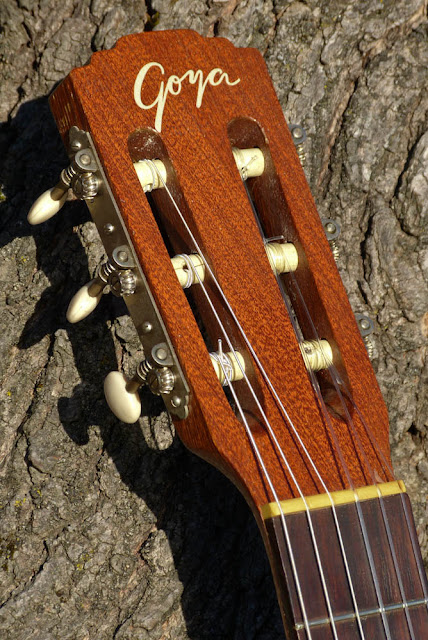1966 Levin-made Goya G-13 Classical/Folk Guitar
Most of you know about my not-so-secret love for these Swedish-made Goyas. The venerable "G-10" model can be found all over the place in the States, but the nicer-quality models are harder to find -- even the slightly nicer models like this G-13 which is, basically, a G-10 with mahogany back and sides in place of birch. Tonally, though, it's half a world different and a much more woody, sweet-sounding beast compared to your average G-10 -- and I think G-10s sound pretty impressive, myself. I like G-13s so much that I actually bought one for my Dad when he was looking for a good, practical classical to play (it now lives in New Mexico).
So, that said, I couldn't pass up this one-owner '66 when it walked in the shop. I bought it on the spot, gave it a fret level/dress, saddle shave, a set of new D'Addario Pro Artes, and a good setup. It came out swell and after work I played an hour's worth of songs on it. Something about the 00-size body (slightly smaller overall than your average "full" classical), 24 3/4" scale length (vs. 26" classical), and light build makes these absurdly-fun "folk" guitars for fingerpicking chords behind voice. With harder-tension strings and a lowballed setup they also make decent flamenco-sounding guitars. The necks are also faster than your average classical with a thin (front to back) flattened D-shape profile but full 2" nut width.
There are no cracks on the guitar and the only sign of age, really, are the yellowed nut and saddle and finish weather-checking seen throughout.
The one-piece mahogany neck is reinforced with an aluminum rod. The original nut is plastic, of course, but the yellowing looks nice on these so I usually leave them in place rather than swap to bone.
Brazilian rosewood board... and freshly-worked frets...
I always like the understated Levin/Goya rosettes compared to your average (somewhat over the top) Spanish-style classical rosettes.
How do you like the bearclaw figure in that spruce, by the way?
In addition to shaving the bridge and lowering the saddle I drilled "through bridge" stringing holes to get better back-tension on the saddle. Stringing is easy -- you pass the string through the hole, pull it up through the soundhole, knot it up, and pull it up to the tuner. It's a stable and practical method and is used on a number of new boutique ukulele builds.
The real reason for it in this case is that the mounting holes on the classical-style "tie block" were too high for nice down-pressure on the saddle with the lowered action during setup. Alternately, the holes could be overdrilled and pins put in their place (though I like the super-secure stringing and tidy look of this setup).
Here's some more of that bearclaw figure...
...and here, too.
The back and sides have pretty, vibrant-looking mahogany.
The tuners are original units and, after a lube, work smoothly.
The serial number and label style point to 1966.
Yes -- the original chip case (in good shape) still has its Goya label!
This guitar went over to Europe in its younger days and spent time going from hostel to hostel and backing folk songs. It's the ideal life for a Levin/Goya.























Comments